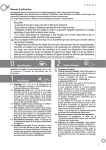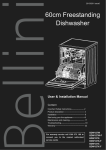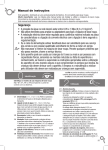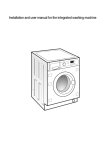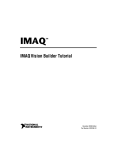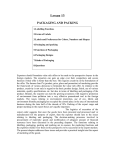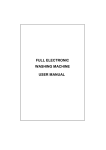Download Installation and user manual
Transcript
I 1 Installation and user manual 1.1 1.1.2 1.1.3 1.2.4 1.4.2 1.2 1.1.1 1.2.1 1.3 1.2.2 1.4 1.4.3 1.2.3 1.4.1 1.5 2 04/13 WF2N00260 / 0089563-00 2.1 2.2 2.2.1 II III 3 2.2.2 2.4 2.2.3 2.4.1 2.2.4 2.2.5 2.4.2 2.3 3.1.3 b 2.4.4 2.4.3 3.1.4 3.2.4 b 3.2.1 3.2.2 3.2.3 3.2.5 4 Select 2.5 2.6 2.6.1 2.6.2 2.7 4.1.1 3” 3” S 2.8 3.2 2.8.1 2.9 2.8.2 4.1.4 5 3 3.1 c 3.1.1 3.1.2 4.1.5 4.1.2 4.1.3 e n g l i s h Instruction manual This appliance, for domestic use only, is designed for washing clothes. Very important: Please, read the whole of this manual before installation and using the washing machine. This manual is designed with the corresponding illustration accompanying the texts. Safety • The mains water pressure must be between 0.05 and 1 Mpa (0.5 - 10 kg/cm2). • Do not use extension leads or adapters to connect the washing machine. • The electrical installation must be suitably dimensioned for the maximum power indicated on the reference plate and the plug must have the regulatory earth connection. • If the power supply cable is damaged, it must be replaced by after-sales service or similarly qualified personnel so as to avoid any hazards. • Do not interfere with the inside of the washing machine. If you have any problems you cannot solve yourself, call the technical service. • This appliance can be used by children aged from 8 years and above and persons with reduced physical, sensory or mental capabilities or lack of experience and knowledge if they have been given supervision or instruction concerning use of the appliance. Cleaning and user maintenance shall not be made by children without supervision. 1 Installation 1.1 Unpacking the washing machine (1.1.1, 1.1.2 and 1.1.3). Remove the transit brackers and the fixing and blocking elements used for transport. 1.2 Connection to the mains water (1.2.1, 1.2.2 and 1.2.3). If the washing machine has a hot water intake, connect the red hose to the hot water tap (1.2.4). Always use the new hose supplied with the appliance. Remove any previously used supply tubes. 1.3Draining. Install the elbow supplied, in accordance with the measurements shown in the diagram. 1.4Levelling. Correctly level the washing machine to prevent any noise or shifting. The recommended order is as follows: 1. Position the rear legs and fix them in place (1.4.1). 2. Place the washing machine in its final location (1.4.2). 3. Position the front legs and fix them in place (1.4.3). 1.5 Connection to the mains electric. Refer to the plate data. 1.6 Installation under a worktop. If the worktop needs to be removed in order to recess-mount the washing machine, contact your distributor or Technical Assistance Service. For recess-mounting, the electrical plug must be accessible after installation. Recess dimensions are 600x600x850. 2 Using the washing machine 2.1 Opening the door. 2.2 Detergent and additives. Load the clothes into the washing machine, after sorting them according to colour, soil and fabric type. The detergent compartment has the following divisions: wash , prewash and fabric softener (2.2.1). All the washing machines are designed to use detergent powder (2.2.2). If you wish to use liquid detergent (2.2.3), you will see a blue tab for this purpose in the wash compartment. Pull it outwards as far as it will go, then release it. It will remain in vertical position (2.2.4), this will prevent the liquid detergent from running out. To use powder detergent again, place the blue tab in horizontal position and push it back as far as it will go to open the flap (2.2.5). Remember that you must not exceed the MAX level marked on the fabric softener compartment. 2.3 Switching on the washing machine and programme selection. Select the programme using the dial, after consulting the programme chart (page 3). 2.4 Selecting the spin speed . You can choose or cancel a spin speed (2.4.1, 2.4.2, 2.4.3). If you select the Anti-crease option (2.4.4) the wash process will stop before the final spin and 1 e n g l i s h the clothes will be left submerged in water. If you deactivate the function, it will continue with the final spin. AVERAGE RESIDUAL MOISTURE* (%) COTTON programmes SYNTHETIC programmes WOOL programmes RAPID programme MAXIMUM SPIN SPEED OF THE WASHING MACHINE (rpm) 600 800 80 80 100 100 71 70 90 90 1000 1200 1400 62 70 90 80 53 70 90 80 52 70 90 80 * Residual moisture: the amount of water contained by the clothes at the end of the spin cycle 2.5 Additional functions. - Easy iron . Reduces creasing. - Extra rinse . Provides extra protection for clothes worn by children and people with sensitive skin. - Save time . Press the wash time reduction button up to three times to reduce the duration of the selected wash programme. The reduced wash programme time will appear on the display. 2.6 Time delay . This option allows you to delay the start of washing. 2.7 Starting up the washing machine . 2.8 Child lock. Press and hold it down approximately 3 seconds (2.8.1). This is used to prevent children from interfering with the washing machine. It is deactivated by pressing the button again and holding it down approximately 3 seconds (2.8.2). 2.9 Wash process. You can check the programme phase and the remaining programme time. Recommendations for use - As soon as the washing machine is installed you can perform a preliminary wash to check it is functioning correctly (standard wash, with no load and at 90ºC). - Use a wash bag for small items: handkerchiefs and underwear. - Any type of washing machine detergent may be used. Liquid detergents are recommended for low temperature wash programmes (maximum 40ºC) for all types of fabrics. Powder detergent is not recommended for washing wool. Observations: 1. If you stop the washing machine to add more items to the load, make sure the water level is below the loading door. 2. The additional functions easy iron ( ), extra rinse ( ) increase the washing time. 3. Once the wash programme has finished we recommend you leave the door open to ventilate the inside. You may have to wait for 2 minutes to open the door. 2 3 Maintenance 4 Troubleshooting 5 The environment 3.1 Cleaning the detergent compartment. It is recommendable to do this once a month. 3.2 Cleaning the filter. It is recommendable to do this once a year. For cleaning the outside of the washing machine, use non-abrasive products and dry thoroughly with a soft cloth. 4.1 The washing machine includes a troubleshooting system which detects and warns of any anomalies. This can be viewed on the display or when the pilot lights on the control panel start to flash. 4.1.1 No water is entering the washing machine. Check the water supply, the inlet tap, or clean the inlet filter. 4.1.2 The washing machine does not drain or spin. Check the state of the filter. 4.1.3 It does not spin. Redistribute the load and press the spin button again. 4.1.4 It will not start up. Check the loading door is properly closed. 4.1.5 Any other code. Contact the technical service. 4.2 Vibrations or noise. Check it has been properly installed (points 1.1 and 1.4 of this manual). 4.3 Water in the detergent compartment. Check the detergent compartment is not clogged (3.1). This washing machine has been designed with environmental protection in mind. While the washing machine is operating the display and/or the pilot lights will stay on. When it is not operating, after 20 minutes, the display will switch itself off and only the “stop” pilot light will stay on. To activate the display, press any of the buttons or turn the control. Power consumed in “off” mode and “left on” mode <0,5 W. Respect the environment. Always load the washing machine to the maximum recommended capacity for each programme: this will save water and power. Avoid the prewash whenever you can. Do not use too much detergent. Waste electrical and electronic equipment management. Do not dispose of these appliances together with the general domestic waste. Take your washing machine to a special waste collection centre. Recycling domestic appliances avoids negative consequences for health and the environment and saves power and natural resources. For further information, contact your local authorities or the shop you purchased the washing machine at. e n g l i s h Maximum load (Kg), consumption (kWh/l) and approx. duration of the programs (min) Programme chart Kg kWh/l cotton cold cotton/linen very light soil 6 0,15/49 104 7 0,15/50 104 2. cotton 20ºC cotton/linen very light soil 6 0,20/49 114 7 0,20/50 114 3. cotton 30ºC cotton/linen very light soil 6 0,35/49 115 7 0,35/50 115 4. cotton (*) 40ºC cotton/linen medium soil 6 A+0,66/49 A++0,60/49 174 7 A++0,67/50 A+++0,60/50 174 5. cotton (*) 60ºC cotton/linen medium soil 6 A+1,04/49 A++0,96/49 178 7 A++1,03/50 A+++0,97/50 178 6. cotton 90ºC cotton/linen/white heavy soil 6 1,80/55 140 7 2,10/56 140 7. synthetics cold synthetics/cotton mix very light soil 3 0,15/45 82 3 0,15/45 82 8. synthetics 30ºC synthetics/cotton mix very light soil 3 0,30/45 120 3 0,30/45 120 9. synthetics 40ºC synthetics/cotton mix very light soil 3 0,50/45 128 3 0,50/45 128 standard programmes min. Kg máx. kWh/l min. 10. wool 30ºC wool/wool mix/whites/colours very light soil 1 0,35/44 40 1 0,35/44 40 11. prewash 60ºC synthetics/wool mix/whites heavy soil 6 1,20/54 130 7 1,30/55 130 12. spin dry cotton/cotton mix/synthetics 6 0,05/0 11 7 0,05/0 11 cotton/cotton mix/synthetics 3 0,05/31 28 3 0,05/32 28 synthetics/cotton mix/delicate colours very light soil 3 0,30/60 131 3 0,30/60 131 1,5 0,20/30 30 1,5 0,20/30 30 13. 14. 15. rinse dark colours quick 30 min. cotton/linen/white/colour very light soil (*) Standard 40ºC and 60ºC cotton programmes, the most efficient in terms of combined energy and water consumptions, suitable NOTES delicate programmes 7 kg máx. 1. special programmes 6 kg for washing normally-soiled cotton laundry. - The real water temperature may differ from the temperature shown for the wash cycle: it may be lower. - The real values for kWh, litres and programme duration may differ from those shown depending on the pressure and temperature of the mains water supply, the temperature of the room the washing machine is located in, mains voltage fluctuations, the type and amount of garments making up the load and any additional options selected. 3





